www.chechurubiera.info - an online magazine for fans of Chechu Rubiera

 VUELTA A ESPAÑA
VUELTA A ESPAÑA
Introduction
CHECHU RUBIERA
Rubiera Retro : Fan Diary from Asturias : Ciclismo Fondo in Asturias with Chechu : Dad In Support
VUELTA RETRO
1936 : Julián Berrendero : Luis Ocaña : José Manuel Fuente : Pedro Delgado
SPAIN
Vigo : The Way of St James : Covadonga : Prince of Asturias Award : Mountain Facts : Exploring the Alhambra : The Pass of the Moor's Sigh
PEOPLE
Famous Galicians : Prince of Asturias : Catherine of Aragon : Federico García Lorca
CULTURE
Bull Run : Siesta : Interiors - Jaime Hayon, Nani Marquina : Saving El Burro : Spanish Nicknames
FOOD
5 To Try : Atlantic Spain : Fabada Asturiana : Growing Fabada Beans : About Olives
BOOKS
¡Guerra!
FOOD
FABADA ASTURIANA
Saviour of Spain. Or sausage and beans. Fabada Asturiana is a high-fat, sleep-inducing (and delicious) stew made with pork, blood sausage and white beans, and reportedly Chechu's favourite food!
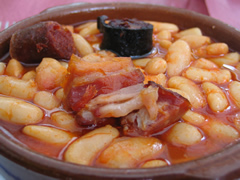 Ingredients : 2 cups, Asturian white beans, soaked overnight : 1 smoked black sausage : 1 chorizo : 4oz salt pork : 4oz lean pork (smoked if you like) : 1 pinch of saffron : salt and pepper to taste
Ingredients : 2 cups, Asturian white beans, soaked overnight : 1 smoked black sausage : 1 chorizo : 4oz salt pork : 4oz lean pork (smoked if you like) : 1 pinch of saffron : salt and pepper to taste
Method : Rinse and drain the beans, place them in a pot with enought water to cover and bring to the boil. Add the pork, reduce the heat and simmer for one hour. Add the chorizo, black pudding and the saffron. Cook for half an hour. Add the salt and pepper. Serve immediately. Serves 4.
from Lonely Planet's World Food Spain
FOOD
REBECCA BELL : GROWING FABADA BEANS
Fabada, the rich Asturian bean soup, is delicious and easy to make. But if you live outside of Spain, it’s a pricey recipe. The beans, which must be imported, are expensive. Yes, cooks, it is possible to substitute another type of bean. But that’s not genuine fabada, and therefore no fun!
At our house, when Chechu races we indulge in ritual cooking and eating of fabada. Chechu has raced thousands of miles in 2007, so we’ve decided to see if it’s possible to grow our own crop of beans and save a few dollars.
Here’s an experiment for the urban garden or the classroom. It’s easy to do, and makes a fun science lesson for kids.
You will need: fabada beans, sprouting or rooting medium, a small glass or jar.
Beans intended for cooking can be used for seed, and can be purchased from a Spanish food specialist. Use whole unblemished beans. To sprout them, put some sprouting medium, like Spanish moss, into a glass. Tuck the beans down into the moss, then fill the glass with water. Allow a few minutes for the sprouting medium to become saturated, then drain.
Put the glass in a window sill where you can check it daily. Keep the medium moist, but don’t allow water to stand in the bottom of the glass. In a few days, roots will form. In about a week, green sprouts will appear.
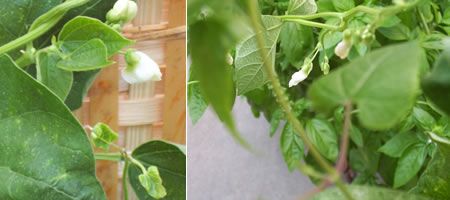 When the sprouts are sturdy and several inches high, transplant them into your garden. Dig a hole about 5” (12 cm) deep. Carefully put the entire contents of the glass into the hole, taking care not to break the sprouts. Lightly fill in the hole with soil, leaving the tops of the sprouts free and exposed to the sunlight.
When the sprouts are sturdy and several inches high, transplant them into your garden. Dig a hole about 5” (12 cm) deep. Carefully put the entire contents of the glass into the hole, taking care not to break the sprouts. Lightly fill in the hole with soil, leaving the tops of the sprouts free and exposed to the sunlight.
Water the sprouts regularly. A thriving vine with tendrils will abundantly reward your efforts, and will eventually require the support of a trellis or a large tomato cage.
A bean planted in May, when Chechu was riding the Giro, is now ready for a home puppet production of Jack and the Beanstalk. It has blossoms and is over 6’ tall. We hope to see beanpods before the end of the Vuelta!
In the USA, you can buy fabada beans to cook or sprout from AMIGO FOODS or LA TIENDA.
CULTURE
INTERIOR DESIGN 1 : JAIME HAYON, NANI MARQUINA
It's an exciting time for contemporary design in Spain, there's a new confidence about. With creative drama, modern lines and conceptual chic, Spanish designers are now rivalling those in Italy and Scandanavia. High street brands like Zara Home are bringing this style across the world.

Jaime Hayon has created a splash with his bathroom range, which includes a vanity unity with curvy tapered legs, mirror and lamp. With a glossy finish and zesty colours, it's all free-standing. Take it with you when you move!
See JAIME HAYON WEBSITE

Colourist Nina Marquina's rugs come in eye-poppingly extrovert shades like fuchsia and tangerine. Experimental textures are another speciality.
See NANI MARQUNIA WEBSITE
FOOD
ATLANTIC SPAIN
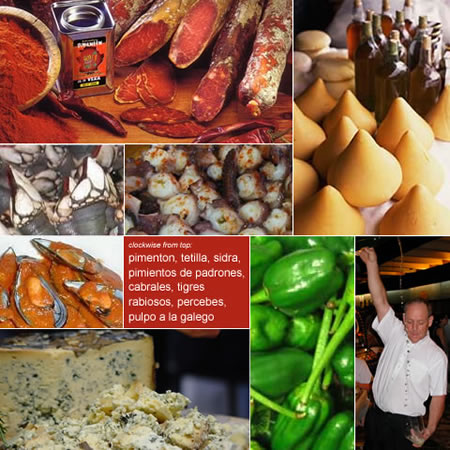
FOOD
FACTS ABOUT OLIVES
Spain is the world's largest producer of olives, growing 262 varieties
90% of the olives produced is sent to the presses for their oil
Olive oil is the chief flavouring agent of Spanish cuisine
Andalucía is Spain's largest olive growing area
There are 165 million olive trees in Andalucía, half of which are in Jaén
Spanish health regulations define three grades of olive oil, virgin, refined and a blend
The finest Spanish olive oils are most often blends
Between sips of oil, tasters chew slices of green apple to clear the palate
The most important varieties of olive inlude the Picual, grown chiefly in Jaén
10% of all olives are preserved and eaten as tapas, and in salads and sauces, the most popular snacking olive is the Manzanilla
CULTURE
BULL RUNNING IN PAMPLONA
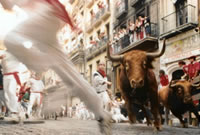 For one week in July, the Navarrese capital, Pamplona, parties. The scariest, loudest and most raucous is the Fiesta de San Fermin, held in honour of Pamplona's patron saint, and celebrated since the early sixteenth century.
For one week in July, the Navarrese capital, Pamplona, parties. The scariest, loudest and most raucous is the Fiesta de San Fermin, held in honour of Pamplona's patron saint, and celebrated since the early sixteenth century.
The daily ritual of the notorious encierro or bull run lasts only a few minutes, when a half dozen bulls run 800m or so to the town's main bullring behind several thousand would-be heroes.
There are bullfights every evening, protests against animal cruelty ... and lots of beer and sangria.
See OFFICIAL SITE
CULTURE
SAVING EL BURRO
The humble donkey is as emblematic of Spain as the bull or flamenco dancer. From Sancho Panza to the straw donkey scooped up by Costa tourists, this beast of burden is synonymous with Spain.
The six species of donkey native to Spain are all in danger of extinction. The working donkey or mule (the offspring of a mare and donkey) is an increasingly rare sight in Spain, although it is still seen in parts of rural Andalucía and Galicia. At the end of the civil war (1939) there were an estimated 1,250,000 donkeys in the country, now there's just 65,000.

El Refugio del Burrito is a donkey sanctuary in Fuente de Piedra, a 45 minute drive north of Malaga. The sanctuary provides a permanent refuge to any donkey or mule in need.
Animal rights are beginning to take hold in Spain, but the sanctuary is still receiving complaints about abandoned animals, many of whom have been mistreated.
You can help by donation, adopting a donkey or holidaying at the sanctuary.
See THE DONKEY SANCTUARY
CULTURE
SIESTA
 Is the Spanish siesta on the verge of exinction? Reports suggest that only 10 per cent of the population still sleep in the siesta.
Is the Spanish siesta on the verge of exinction? Reports suggest that only 10 per cent of the population still sleep in the siesta.
Not so long ago, it was impossible to do business over the phone after two o'clock. Everyone was either indulging in the three-course comida or sleeping it off.
As guiris (Anglo Saxon foreigners) impose their northern values and air-conditioning is installed, there is now less excuse for an afternoon flop.
from Our Lady of the Sewers : Paul Richardson
Dream : Pablo Picasso
CULTURE
"Waking up earlier won't make the sun rise faster."
Spanish proverb
Shocking but true, the Spanish siesta originated in Portugal. Throughout Spain, you'll find nothing doing between 2 and 5pm when the Spaniards do lunch.
FOOD
FIVE TO TRY
Churros Strips of fried dough dunked in viscious chocolate
Jamón serrano Cured ham, perfected in Extremadura
Paella Valencia's famous saffron-flavoured rice and seafood
Pimientos de Padrón Unpredictably hot Galician peppers
Tortilla Egg and potato omelette
from Rough Guides' 25 Ultimate Experiences : Spain
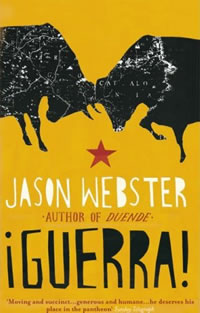
BOOKS
¡GUERRA!
When you're learning about Spain, as we are, you are seduced by the passion and colour. At some point, you encounter the Spanish Civil War, a tumultuous conflict which ripped the country apart in the 1930s and led to nearly forty years of dictatorship.
Jason Webster began to uncover a darker side to Spain after he found an unmarked mass grave close to his home in Valencia. On his journey, he discovers that old anger and animosity lie just below the surface.
This is a compelling, sometimes horrifying read. Yet it opens a revealing window on modern Spain, and even helps an understanding of recent events in Spanish cycling.
CULTURE
SPANISH NICKNAMES
He gets asked the question all the time, why is he called Chechu?
The question is asked because it's an unusual nickname, José is most often shortened to Pepe in Spain. Here are some more.
Alfredo: Fredo
Concepción: Concha, Conchi
Consuelo: Chelo
Delores: Lola, Loli
Enrique: Quique
Francisco: Paco, Curro, Fran, Sisco, Kiko
Gregorio: Goyo
Guadalupe: Lupe
Javier: Javi, Chavi
Juan-Maria: Juanma
José: Pepe, Jose (no accent)
José-Maria: Chema, Josemari
Josefa: Pepa, Pepita
Josefina: Fina
Ignacio: Nacho
Immaculada: Inma
Isabel: Isa
Isidoro: Isi or Doro
Manuel: Manolo
María-Isabel: Marisa, Maribel
Maria del Carmen: Mamen, Menchu, Maica
Mercedes: Merche
Pilar: Pili
Rafael: Rafa
Salvador: Salva, Salvi
